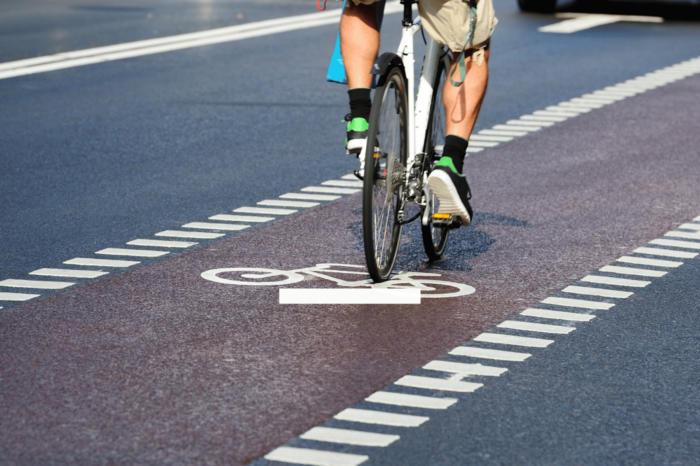Installing bike and bus lanes requires public debate
This op-ed originally appeared in The Boston Globe on June 9, 2023.
They are popping up everywhere. On main streets across the Commonwealth, roads are being redesigned and parking spots and travel lanes are being taken over for bike and bus lanes.
While reducing carbon emissions is a sound goal, achieving this goal without trampling over the rights of residents and small businesses is a real challenge.
Increasingly, we see municipalities install bike and bus lanes with little public debate or notice. Seniors, the disability community, neighborhood associations, or small businesses are not seriously consulted.
In Boston, bus and bike lanes implemented on an emergency basis during the shutdown of the Orange Line were simply decreed by city officials to be permanent even after the shutdown ended. This scene played out in other communities across the state — from Cambridge to Northampton. During the height of COVID-19, what were billed by Cambridge officials as “temporary, quick-build” bike lanes on certain main roads subsequently became permanent without community consultation. New lane elimination and parking reductions plans are accelerating across Greater Boston, further threatening more traffic congestion for commuters and making parking more scarce for small businesses, shoppers, and residents.
The problem isn’t with the concept of bike lanes but, rather, the lack of public conversation or transparency. Municipal governments are changing the infrastructure and character of entire neighborhoods and small commercial centers with little input from those most affected.
Normally, if a city wants to install even a stop light or a crosswalk, there is a fair dose of due process and transparency. Officials determine why the change is needed, produce data on accidents, and solicit feedback from community stakeholders.
But with bike and bus lanes, there is too little due process or transparent decision making. Boston is poised to designate another 9.4 miles of separated bike lanes in addition to the 17.5 miles already completed. A 2019 Cambridge ordinance decreed over 25 miles of separated bike lanes as part of a larger plan for 100 bike lanes in a city that is 6 square miles. Will concerns of residents and small businesses in affected neighborhoods be considered? Too often neither economic nor traffic studies have been developed on the potential loss of sales for small businesses due to inadequate consumer parking; nor the safety concerns from the increased congestion for residents and employers resulting from diverted traffic through neighborhoods.
Advocates frequently argue that bus and bike lanes reduce congestion — but results in Boston thus far suggest the opposite. Boston is the second most congested city in the United States, with drivers spending an additional 134 hours in traffic on average, costing them nearly $2,300 in gas each year. And while rush hour congestion may be 10 percent lower than pre-pandemic heights, given the unreliability of the T and more limited in-office hours, those who have returned are increasingly driving to work. Meanwhile, tens of thousands more are on the roads throughout the day doing business or social errands.
Fewer parking spaces and the narrowing of major roadways to accommodate bike and bus lanes result in stuck traffic, idling delivery trucks, double parking, and newly congested side roads with the search for parking and alternate routes. This increases carbon emissions, limits access to small businesses, and makes local neighborhood streets more dangerous to navigate. Examples of these disastrous configurations abound. For example, on Mass. Ave. in Cambridge from City Hall to Harvard Square there are no parking spots for hundreds of residents or delivery vehicles, with delivery drivers often resorting to parking in the middle of the avenue, creating dangerous driving conditions for all. Similarly, those traveling to hospitals in Boston’s Longwood area encounter increased congestion with one travel lane, trolley lines, and separated bike lanes. Cambridge St. in Boston from Government Center past Massachusetts General Hospital has no parking and separated bike lanes, causing massive bottlenecks on this heavily traveled route.
Small businesses on those reconfigured streets have a harder time receiving deliveries and attracting customers, who expect to find convenient parking spots. Seniors have more difficulty finding parking for appointments and people with diminished mobility struggle to safely move from their vehicles to their destinations. Children have to contend with more truck traffic on neighborhood streets.
Too many small businesses and neighborhood groups report that they haven’t been consulted about the impacts of these local infrastructure changes on their livelihoods and quality of life. They either weren’t asked or their concerns were dismissed.
Massachusetts faces real transportation and environmental challenges — but we shouldn’t be afraid of having an honest, open debate about them. It’s time we included more than the activists and policy makers who make these decisions, including also the employers, employees, and consumers who must live with them. And the debates and decisions should be about fair solutions, street by street, and block by block.
Barbara Anthony is a former undersecretary of the Massachusetts Office of Consumer Affairs and Business Regulation and a Senior Fellow at Pioneer Institute. This op-ed was coauthored with Jon Hurst, president of the Retailers Association of Massachusetts.



